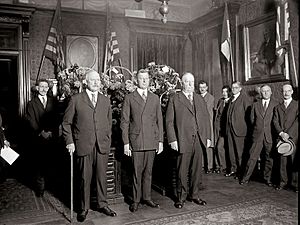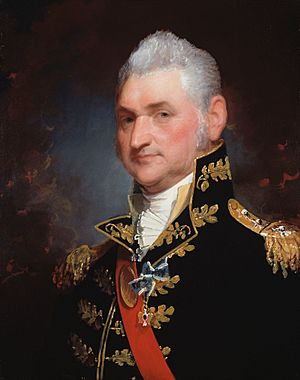United States Secretary of War facts for kids
Quick facts for kids United States Secretary of War |
|
|---|---|

Flag of the secretary
|
|

Official seal
|
|
| United States Department of War | |
| Style | Mr. Secretary |
| Member of | Cabinet |
| Reports to | President of the United States |
| Seat | Washington, D.C. |
| Appointer | The president
with Senate advice and consent
|
| Term length | No fixed term |
| Precursor | Secretary at War |
| Formation | September 12, 1789 |
| First holder | Henry Knox |
| Final holder | Kenneth C. Royall |
| Abolished | September 18, 1947 |
| Succession | 6th in the line of succession |
The Secretary of War was an important job in the U.S. President's team, called the Cabinet. This role started when George Washington became the first President.
Before that, from 1781 to 1789, there was a similar job called "Secretary at War." This person worked for the Congress of the Confederation, which was the government before the U.S. Constitution was written. Benjamin Lincoln and Henry Knox held this early position. When George Washington became President, he asked Henry Knox to continue as Secretary of War.
The Secretary of War was in charge of the War Department. At first, this person handled all military matters, including the Navy. But in 1798, a new job was created: the Secretary of the Navy. After that, the Secretary of War only focused on the United States Army.
From 1886 onwards, the Secretary of War was part of the line of succession to the presidency. This means if the President couldn't do their job, the Vice President would take over, then the Speaker of the House, and so on. The Secretary of War was sixth in this line.
In 1947, a law called the National Security Act of 1947 changed things. The job of Secretary of War was replaced by two new roles: the Secretary of the Army and the Secretary of the Air Force. These new secretaries, along with the Secretary of the Navy, now work under the Secretary of Defense. The Secretary of Defense is the main person in the Cabinet who handles all military matters. The Secretary of the Army's job is often seen as the direct continuation of the old Secretary of War role.
Early Leaders: Secretary at War (1781–1789)
The first "Secretary at War" job was similar to a role in Great Britain. This position was created to replace the military commander and a group called the Board of War. The Secretary at War didn't wear a special uniform. Their team included important military leaders like the inspector general. However, the U.S. Army at that time was very small, with only about 700 soldiers under Secretary Henry Knox.
| Image | No. | Name | Home State | Start | End | Appointer |
|---|---|---|---|---|---|---|
| 1 |  |
Benjamin Lincoln | Massachusetts | March 1, 1781 | November 2, 1783 | Congress of the Confederation |
| 2 |  |
Henry Knox | Massachusetts | March 8, 1785 | September 12, 1789 |
Secretaries of War (1789–1947)
This section lists the people who served as the Secretary of War from when the U.S. Constitution was adopted until the job was changed in 1947.

- Political Parties
Federalist (4) Democratic-Republican (8) Democratic (14) Whig (5) Republican (25)
| Denotes acting capacity. |
| No. | Image | Name | Start | End | Duration | Party | Home State | President(s) | ||
|---|---|---|---|---|---|---|---|---|---|---|
| 1 |  |
Henry Knox | September 12, 1789 | December 31, 1794 | 5 years, 110 days | Federalist | Massachusetts | George Washington (1789–1797) |
||
| 2 |  |
Timothy Pickering | January 2, 1795 | December 10, 1795 | 342 days | Federalist | Pennsylvania | |||
| 3 |  |
James McHenry | January 27, 1796 | June 1, 1800 | −4 years, 125 days | Federalist | Maryland | |||
| John Adams (1797–1801) |
||||||||||
| 4 |  |
Samuel Dexter | June 1, 1800 | January 31, 1801 | 244 days | Federalist | Massachusetts | |||
| 5 |  |
Henry Dearborn | March 5, 1801 | March 4, 1809 | 7 years, 364 days | Democratic-Republican | Massachusetts | Thomas Jefferson (1801–1809) |
||
| 6 |  |
William Eustis | March 7, 1809 | January 13, 1813 | 3 years, 312 days | Democratic-Republican | Massachusetts | James Madison (1809–1817) |
||
| 7 |  |
John Armstrong Jr. | January 13, 1813 | September 27, 1814 | 1 year, 257 days | Democratic-Republican | New York | |||
| 8 |  |
James Monroe | September 27, 1814 | March 2, 1815 | 156 days | Democratic-Republican | Virginia | |||
| 9 |  |
William H. Crawford | August 1, 1815 | October 22, 1816 | 1 year, 82 days | Democratic-Republican | Georgia | |||
| 10 |  |
John C. Calhoun | October 8, 1817 | March 4, 1825 | 7 years, 147 days | Democratic-Republican | South Carolina | James Monroe (1817–1825) |
||
| 11 |  |
James Barbour | March 7, 1825 | May 23, 1828 | 3 years, 77 days | Democratic-Republican | Virginia | John Quincy Adams (1825–1829) |
||
| 12 |  |
Peter Buell Porter | May 23, 1828 | March 9, 1829 | 290 days | Democratic-Republican | New York | |||
| 13 |  |
John Eaton | March 9, 1829 | June 18, 1831 | 2 years, 101 days | Democratic | Tennessee | Andrew Jackson (1829–1837) |
||
| 14 |  |
Lewis Cass | August 1, 1831 | October 5, 1836 | 5 years, 65 days | Democratic | Ohio | |||
| 15 |  |
Joel Roberts Poinsett | March 7, 1837 | March 4, 1841 | 3 years, 362 days | Democratic | South Carolina | Martin Van Buren (1837–1841) |
||
| 16 |  |
John Bell | March 5, 1841 | September 13, 1841 | 193 days | Whig | South Carolina | William Henry Harrison (1841) |
||
| John Tyler (1841–1845) |
||||||||||
| 17 |  |
John Canfield Spencer | October 12, 1841 | March 4, 1843 | 1 year, 143 days | Whig | New York | |||
| 18 |  |
James Madison Porter | March 8, 1843 | February 14, 1844 | 347 days | Whig | Pennsylvania | |||
| 19 |  |
William Wilkins | February 15, 1844 | March 4, 1845 | 1 year, 17 days | Democratic | Pennsylvania | |||
| 20 |  |
William Learned Marcy | March 6, 1845 | March 4, 1849 | 3 years, 363 days | Democratic | New York | James K. Polk (1845–1849) |
||
| 21 |  |
George W. Crawford | March 8, 1849 | July 22, 1850 | 1 year, 136 days | Whig | Georgia | Zachary Taylor (1849–1850) |
||
| 22 |  |
Charles Magill Conrad | August 15, 1850 | March 4, 1853 | 2 years, 201 days | Whig | Louisiana | Millard Fillmore (1850–1853) |
||
| 23 |  |
Jefferson Davis | March 7, 1853 | March 4, 1857 | 3 years, 362 days | Democratic | Mississippi | Franklin Pierce (1853–1857) |
||
| 24 |  |
John B. Floyd | March 6, 1857 | December 29, 1860 | 3 years, 298 days | Democratic | Virginia | James Buchanan (1857–1861) |
||
| 25 |  |
Joseph Holt | January 18, 1861 | March 4, 1861 | 45 days | Republican | Kentucky | |||
| 26 |  |
Simon Cameron | March 5, 1861 | January 14, 1862 | 315 days | Republican | Pennsylvania | Abraham Lincoln (1861–1865) |
||
| 27 |  |
Edwin M. Stanton | January 20, 1862 Suspended: August 12, 1867 – January 14, 1868 |
May 28, 1868 | 6 years, 129 days | Republican | Pennsylvania | |||
| Andrew Johnson (1865–1869) |
||||||||||
| – |  |
Ulysses S. Grant Acting |
August 12, 1867 | January 14, 1868 | 155 days | Republican | Ohio | |||
| 28 |  |
John McAllister Schofield | June 1, 1868 | March 13, 1869 | 285 days | Republican | Illinois | |||
| 29 |  |
John Aaron Rawlins | March 13, 1869 | September 6, 1869 | 177 days | Republican | Illinois | Ulysses S. Grant (1869–1877) |
||
| – |  |
William Sherman Acting |
September 6, 1869 | October 25, 1869 | 49 days | Republican | Ohio | |||
| 30 |  |
William W. Belknap | October 25, 1869 | March 2, 1876 | 6 years, 129 days | Republican | Iowa | |||
| 31 |  |
Alphonso Taft | March 8, 1876 | May 22, 1876 | 81 days | Republican | Ohio | |||
| 32 |  |
J. Donald Cameron | May 22, 1876 | March 4, 1877 | 286 days | Republican | Pennsylvania | |||
| 33 |  |
George W. McCrary | March 12, 1877 | December 10, 1879 | 2 years, 273 days | Republican | Iowa | Rutherford B. Hayes (1877–1881) |
||
| 34 |  |
Alexander Ramsey | December 10, 1879 | March 4, 1881 | 1 year, 84 days | Republican | Minnesota | |||
| 35 |  |
Robert Todd Lincoln | March 5, 1881 | March 4, 1885 | 3 years, 364 days | Republican | Illinois | James A. Garfield (1881) |
||
| Chester A. Arthur (1881–1885) |
||||||||||
| 36 |  |
William Crowninshield Endicott | March 5, 1885 | March 4, 1889 | 3 years, 364 days | Democratic | Massachusetts | Grover Cleveland (1885–1889) |
||
| 37 |  |
Redfield Proctor | March 5, 1889 | November 5, 1891 | 2 years, 245 days | Republican | Vermont | Benjamin Harrison (1889–1893) |
||
| 38 |  |
Stephen Benton Elkins | December 17, 1891 | March 4, 1893 | 1 year, 77 days | Republican | West Virginia | |||
| 39 |  |
Daniel S. Lamont | March 5, 1893 | March 4, 1897 | 3 years, 364 days | Democratic | New York | Grover Cleveland (1885–1889) |
||
| 40 |  |
Russell A. Alger | March 5, 1897 | August 1, 1899 | 2 years, 149 days | Republican | Michigan | William McKinley (1897–1901) |
||
| 41 |  |
Elihu Root | August 1, 1899 | January 31, 1904 | 4 years, 183 days | Republican | New York | |||
| Theodore Roosevelt (1901–1909) |
||||||||||
| 42 |  |
William Howard Taft | February 1, 1904 | June 30, 1908 | 4 years, 150 days | Republican | Ohio | |||
| 43 |  |
Luke Edward Wright | July 1, 1908 | March 4, 1909 | 246 days | Republican | Tennessee | |||
| 44 |  |
Jacob M. Dickinson | March 12, 1909 | May 21, 1911 | 2 years, 70 days | Democratic | Tennessee | William Howard Taft (1909–1913) |
||
| 45 |  |
Henry L. Stimson | May 22, 1911 | March 4, 1913 | 1 year, 286 days | Republican | New York | |||
| 46 |  |
Lindley Miller Garrison | March 5, 1913 | February 10, 1916 | 2 years, 342 days | Democratic | New Jersey | Woodrow Wilson (1913–1921) |
||
| 47 |  |
Newton D. Baker | March 9, 1916 | March 4, 1921 | 4 years, 360 days | Democratic | Ohio | |||
| 48 |  |
John W. Weeks | March 5, 1921 | October 13, 1925 | 4 years, 223 days | Republican | Massachusetts | Warren G. Harding (1921–1923) |
||
| Calvin Coolidge (1923–1929) |
||||||||||
| 49 |  |
Dwight F. Davis | October 14, 1925 | March 4, 1929 | 3 years, 141 days | Republican | Missouri | |||
| 50 |  |
James William Good | March 6, 1929 | November 18, 1929 | 257 days | Republican | Iowa | Herbert Hoover (1929–1933) |
||
| 51 |  |
Patrick J. Hurley | December 9, 1929 | March 4, 1933 | 3 years, 85 days | Republican | Oklahoma | |||
| 52 |  |
George Dern | March 4, 1933 | August 27, 1936 | 3 years, 176 days | Democratic | Utah | Franklin D. Roosevelt (1933–1945) |
||
| 53 |  |
Harry Hines Woodring | September 25, 1936 | June 20, 1940 | 3 years, 298 days | Democratic | Kansas | |||
| 54 |  |
Henry L. Stimson | July 10, 1940 | September 21, 1945 | 5 years, 73 days | Republican | New York | |||
| Harry S. Truman (1945–1953) |
||||||||||
| 55 |  |
Robert P. Patterson | September 27, 1945 | July 18, 1947 | 1 year, 294 days | Republican | New York | |||
| 56 |  |
Kenneth Royall | July 19, 1947 | September 18, 1947 | 61 days | Democratic | North Carolina | |||
See also
 In Spanish: Secretario de Guerra de los Estados Unidos para niños
In Spanish: Secretario de Guerra de los Estados Unidos para niños
- Confederate States Secretary of War
- United States Secretary of Defense


